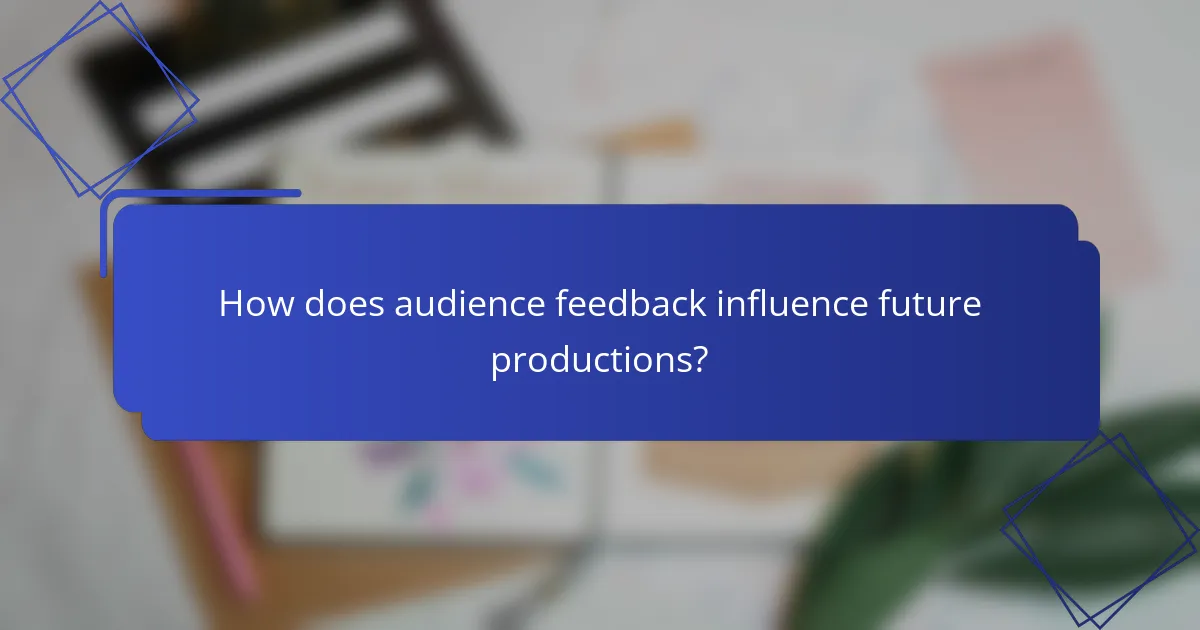Audience feedback is essential for influencing future productions, offering valuable insights into viewer preferences and expectations. By utilizing various methods such as surveys and focus groups, creators can gather meaningful data that informs their content decisions, ensuring a stronger connection with their audience.

How does audience feedback influence future productions?
Audience feedback plays a crucial role in shaping future productions by providing insights into viewer preferences and expectations. This feedback helps creators refine their content, ensuring it resonates more effectively with the target audience.
Improved content quality
Incorporating audience feedback can significantly enhance the quality of content produced. By analyzing viewer responses, creators can identify strengths and weaknesses in their work, allowing for targeted improvements. For example, if viewers consistently express dissatisfaction with pacing, future productions can adjust their narrative flow accordingly.
Regularly soliciting feedback through surveys or social media can help maintain a pulse on audience sentiments. This iterative process ensures that content evolves to meet changing tastes and standards, leading to higher overall quality.
Enhanced audience engagement
When audiences see their feedback being implemented, their engagement levels often increase. This sense of involvement fosters a community around the production, encouraging viewers to participate in discussions and share their thoughts. Engaging with the audience through Q&A sessions or live polls can also deepen their connection to the content.
Furthermore, productions that actively respond to feedback are more likely to cultivate loyalty among their viewers. This loyalty can translate into higher viewership numbers and increased word-of-mouth promotion, which is invaluable in today’s competitive landscape.
Informed decision-making
Audience feedback provides critical data that can guide decision-making for future projects. By understanding what elements resonate with viewers, producers can make informed choices about casting, storylines, and marketing strategies. For instance, if a particular genre or theme receives positive feedback, it may warrant further exploration in upcoming productions.
Additionally, analyzing trends in audience feedback can help identify potential risks and opportunities. This proactive approach allows creators to pivot quickly in response to viewer preferences, ultimately leading to more successful productions that align with audience desires.

What are effective methods for collecting audience feedback?
Effective methods for collecting audience feedback include surveys, focus groups, and social media polls. Each method offers unique advantages and can provide valuable insights into audience preferences and experiences.
Surveys and questionnaires
Surveys and questionnaires are structured tools that gather quantitative and qualitative data from audiences. They can be distributed online or in person, allowing for a broad reach and the ability to collect responses from a diverse audience.
When designing surveys, keep questions clear and concise. Aim for a mix of multiple-choice and open-ended questions to capture both specific data and detailed feedback. Consider using platforms like SurveyMonkey or Google Forms, which offer user-friendly interfaces and data analysis tools.
Focus groups
Focus groups involve guided discussions with a small group of participants, typically ranging from six to ten individuals. This method allows for in-depth exploration of audience opinions and feelings about a production.
To conduct effective focus groups, select participants that represent your target audience and prepare open-ended questions to stimulate conversation. Ensure a skilled moderator facilitates the discussion to keep it on track and encourage participation from all members.
Social media polls
Social media polls are quick and interactive ways to gather audience feedback directly through platforms like Twitter, Instagram, or Facebook. These polls can engage a large audience and provide immediate insights into preferences or opinions.
When using social media polls, keep questions simple and relevant to current productions or topics. Utilize features like Instagram Stories or Twitter polls to maximize engagement. Remember to analyze the results promptly to inform future decisions and enhance audience connection.

What role does data analysis play in interpreting feedback?
Data analysis is crucial for interpreting audience feedback as it transforms raw opinions into actionable insights. By systematically examining feedback, producers can identify strengths and weaknesses in their productions, ultimately guiding future decisions.
Identifying trends and patterns
Identifying trends and patterns in audience feedback helps producers understand what resonates with viewers over time. For instance, consistent mentions of pacing issues or character development can indicate areas needing improvement. Analyzing feedback across multiple productions can reveal long-term preferences that inform future projects.
Producers can utilize tools like sentiment analysis software to visualize these trends, making it easier to spot recurring themes. Regularly reviewing feedback can help ensure that productions align with audience expectations.
Measuring audience sentiment
Measuring audience sentiment involves assessing the emotional tone of feedback to gauge overall reception. This can be done through surveys, social media analysis, or direct audience comments. Understanding whether feedback is predominantly positive, negative, or neutral allows producers to adjust their strategies accordingly.
Using a simple scoring system, such as a 1-5 scale, can provide a quick overview of audience sentiment. Tracking these scores over time can reveal shifts in audience perception, helping producers make informed decisions about future productions.
Segmenting audience demographics
Segmenting audience demographics is essential for tailoring productions to specific viewer groups. By analyzing feedback based on age, gender, location, and viewing habits, producers can identify which segments respond positively or negatively to certain elements. This targeted approach can enhance engagement and satisfaction.
For example, younger audiences may prefer faster-paced narratives, while older viewers might appreciate deeper character development. Understanding these preferences allows producers to create content that appeals to diverse audience segments, maximizing reach and impact.

How can feedback shape production planning?
Feedback plays a crucial role in shaping production planning by providing insights into audience preferences and expectations. By analyzing this feedback, producers can make informed decisions that enhance the relevance and appeal of future projects.
Adjusting content themes
Feedback allows producers to identify which themes resonate most with their audience. For instance, if viewers express a strong interest in sustainability topics, future productions can incorporate more environmentally focused narratives.
Producers should regularly review audience feedback to spot emerging trends and adjust content themes accordingly. This proactive approach ensures that productions remain engaging and relevant, potentially increasing viewership and audience loyalty.
Modifying production schedules
Audience feedback can indicate the best times for releasing new content. If surveys reveal that viewers prefer weekend releases, producers might shift their schedules to align with this preference, maximizing viewership.
Additionally, feedback can highlight the need for quicker turnaround times on popular series. By adjusting production schedules based on audience demand, producers can capitalize on trends and maintain viewer interest.
Allocating resources effectively
Understanding audience feedback helps in making informed decisions about resource allocation. For example, if feedback shows a preference for high-quality visuals, producers may choose to invest more in cinematography and special effects.
Producers should evaluate feedback to determine which aspects of production yield the highest viewer satisfaction. This can lead to more strategic investments, ensuring that resources are directed toward elements that enhance the overall production quality and viewer experience.

What are the challenges in implementing audience feedback?
Implementing audience feedback presents several challenges that can hinder its effectiveness. Key issues include resistance to change, data overload, and the difficulty of balancing diverse opinions.
Resistance to change
Many organizations face resistance to change when trying to incorporate audience feedback into their productions. Stakeholders may be hesitant to alter established processes or creative visions based on external input. This resistance can stem from a fear of losing artistic integrity or a belief that audience preferences are not aligned with the production’s goals.
To overcome this, it is essential to foster a culture that values feedback as a tool for improvement rather than a threat. Engaging stakeholders early in the feedback process can help mitigate concerns and encourage a more open mindset.
Data overload
Data overload occurs when organizations receive an overwhelming amount of feedback, making it difficult to discern actionable insights. With various platforms available for audience interaction, feedback can come in many forms, including surveys, social media comments, and direct messages. Sifting through this information can be time-consuming and may lead to analysis paralysis.
To manage data overload, prioritize feedback sources based on relevance and impact. Establish clear criteria for evaluating feedback and focus on key themes that emerge from the data. This approach will streamline the process and help identify the most valuable insights.
Balancing diverse opinions
Balancing diverse opinions is a significant challenge when implementing audience feedback. Different audience segments may have conflicting preferences, making it hard to satisfy everyone. For instance, younger viewers might prefer innovative storytelling techniques, while older audiences may favor traditional narratives.
To navigate this complexity, consider segmenting feedback by audience demographics and prioritizing changes that align with the production’s core vision. Engaging in dialogue with different audience groups can also provide clarity on which aspects of feedback are most critical to address.

How can production companies leverage feedback for marketing?
Production companies can effectively use audience feedback to enhance their marketing strategies by identifying viewer preferences and tailoring campaigns accordingly. This approach not only boosts engagement but also increases the likelihood of attracting a wider audience.
Creating targeted advertising campaigns
Targeted advertising campaigns focus on specific audience segments based on feedback gathered from previous productions. By analyzing viewer demographics, preferences, and behaviors, companies can craft messages that resonate more deeply with potential viewers.
For instance, if feedback indicates that a particular genre appeals to a younger audience, marketing efforts can be directed towards platforms popular with that demographic, such as social media channels or streaming services. This targeted approach often yields higher conversion rates compared to broad, generalized advertising.
To create effective targeted campaigns, production companies should consider the following steps: segment the audience based on feedback, develop tailored messaging for each segment, and choose the right channels for distribution. Regularly revisiting and updating these segments based on new feedback ensures that campaigns remain relevant and impactful.



